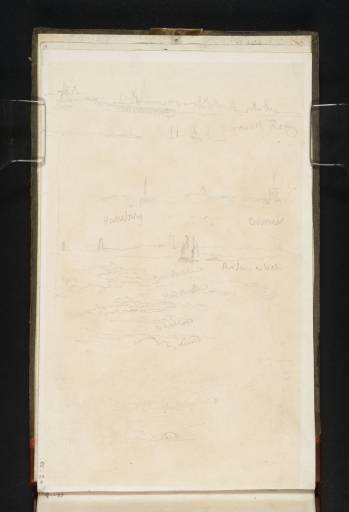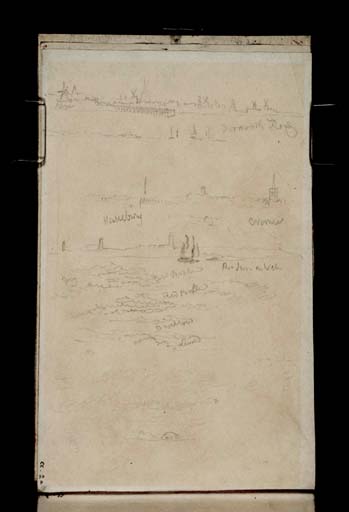Joseph Mallord William Turner Great Yarmouth and the Coast Near Cromer or Happisburgh; and Sunrise Studies 1822
Image 1 of 2
Joseph Mallord William Turner,
Great Yarmouth and the Coast Near Cromer or Happisburgh; and Sunrise Studies
1822
Joseph Mallord William Turner 1775–1851
Folio 2 Verso:
Great Yarmouth and the Coast Near Cromer or Happisburgh; and Sunrise Studies 1822
D17511
Turner Bequest CC 2a
Turner Bequest CC 2a
Pencil on white wove paper, 187 x 114 mm
Inscribed in pencil by Turner, going down the page left to right, ?‘sands’ ‘Yarmouth Roads’ | ‘Haseburg’ ‘Cromer’ | ‘Grey’ ‘Gold Purple’ ‘Red sun on water’ | ‘Red Purple’ | ‘Yellow’ | ?‘Lurid’ [or ‘Land’]
Inscribed in pencil by ?Finberg ‘CC.2a’ bottom left descending
Blindstamped with the with the Turner Bequest stamp bottom right
Inscribed in pencil by Turner, going down the page left to right, ?‘sands’ ‘Yarmouth Roads’ | ‘Haseburg’ ‘Cromer’ | ‘Grey’ ‘Gold Purple’ ‘Red sun on water’ | ‘Red Purple’ | ‘Yellow’ | ?‘Lurid’ [or ‘Land’]
Inscribed in pencil by ?Finberg ‘CC.2a’ bottom left descending
Blindstamped with the with the Turner Bequest stamp bottom right
Accepted by the nation as part of the Turner Bequest 1856
Exhibition history
1857
Marlborough House, London, and other venues, 1857–8 (233 [NG no.438d]).
References
1904
E.T. Cook and Alexander Wedderburn (eds.), Library Edition: The Works of John Ruskin: Volume XIII: Turner: The Harbours of England; Catalogues and Notes, London 1904, pp.300–1.
1909
A.J. Finberg, A Complete Inventory of the Drawings of the Turner Bequest, London 1909, vol.I, p.610, CC 2a, as ‘“Yarmouth Roads,” “Cromer,” and “Hapsburg” (Happisburgh); also sunset. Reverse of 438d, N.G.’.
1981
Gerald Finley, Turner and George the Fourth in Edinburgh 1822, exhibition catalogue, Tate Gallery, London 1981, pp.81, [92] reproduced as ‘“Yarmouth Roads”, “Cromer”, “Hapsburg”, [Happisburgh]; also sunset. Reverse of National Gallery 438d (see p.2 above)’.
Turner continued his journey north (see folio 1 verso; D17509) with more sketches of the Norfolk coast on this page which is turned to the right. At the top are three sketches of ‘Yarmouth Roads’, the second one continuing from the right side of the first. In addition to the pier and the spire of St Nicholas Church, the coast is punctuated at close intervals with windmills. Turner looks back over his shoulder at Great Yarmouth from the north for his third sketch, this time including only the most notable landmarks: the church, the pier and the Norfolk Naval Pillar. See folio 2 (D17510) for further sketches of Great Yarmouth and more information.
The sketch at the centre of the page poses a problem because it carries two inscriptions: ‘Haseburg’ (Happisburgh) and ‘Cromer’. It cannot be both places as they are about twelve miles apart, and it is unlikely to be any of the small villages or hamlets in between. The three towers in the sketch do not resolve the issue as both Happisburgh and Cromer have tall church towers and while Happisburgh had two lighthouses to the east of the church, Cromer had a lighthouse in Foulness to the east and a number or possible churches beyond that at Overstand or Sidestand that could account for the third structure. Perhaps Turner himself did not know which he was drawing so wrote two possibilities. Of the two, Cromer is perhaps the more likely. It is a larger town and more significant landmark which was depicted by artists from the Norwich School. It also has a cliff to the north that falls away in the same manner as the one at the right of the drawing. Turner, however, did take an interest in Happisburgh, painting it around 1830: Harborough Sands, circa 1830 (private collection).1
The sketches at the bottom half of this page belong to a sequence of studies of a sunrise (continued on folio 3; D17512), although the upper sketch of the two in the present page may in fact show a sunset, as the disc of the sun is seen between horizontal layers of different coloured cloud: ‘Red Gold’, ‘Red Purple’, and ‘yellow’, with a ‘grey’ patch in the top left of the sketch, above the ‘land’. At the bottom of the page is the first sketch that Ruskin described as ‘Memoranda of sunrise’, showing just the top of the sun as it first appeared above the horizon of the sea, with clouds above. These two pages were chosen by Ruskin for exhibition as ‘good examples of his [Turner’s] mode of studying skies’, and more generally as examples of leaves from Turner’s ‘smaller note-books, on which [...] his peculiar eminence as a painter chiefly depended’:
It was in these that his observations of nature were accumulated, day by day, and moment by moment, until his mind became an inexhaustible treasury of natural facts, which imagination might afterwards, arrange and combine at her pleasure.2
Bearing in mind the extensive display of these leaves at Marlborough House and in touring exhibitions for the next seven or eight decades, these comments by Ruskin, and his illustration of the continuation of this sunrise study on folio 3, these two pages must have had a significant impact on the public and scholarly understanding of Turner’s sketching practice and his study of nature.
Technical notes:
This page was detached by John Ruskin for exhibition in the Turner rooms of Malborough House, and was subsequently shown are various touring venues. It shows signs of having been exhibited, the whole page except for a 5 mm border having yellowed from exposure to light. Furthermore the Turner Bequest number (‘CC 2a’) has been inscribed at the bottom left of the page in pencil, suggesting that it was not attached to the sketchbook when it was first included in the inventory by Finberg.
This page was detached by John Ruskin for exhibition in the Turner rooms of Malborough House, and was subsequently shown are various touring venues. It shows signs of having been exhibited, the whole page except for a 5 mm border having yellowed from exposure to light. Furthermore the Turner Bequest number (‘CC 2a’) has been inscribed at the bottom left of the page in pencil, suggesting that it was not attached to the sketchbook when it was first included in the inventory by Finberg.
Thomas Ardill
September 2008
How to cite
Thomas Ardill, ‘Great Yarmouth and the Coast Near Cromer or Happisburgh; and Sunrise Studies 1822 by Joseph Mallord William Turner’, catalogue entry, September 2008, in David Blayney Brown (ed.), J.M.W. Turner: Sketchbooks, Drawings and Watercolours, Tate Research Publication, December 2012, https://www


